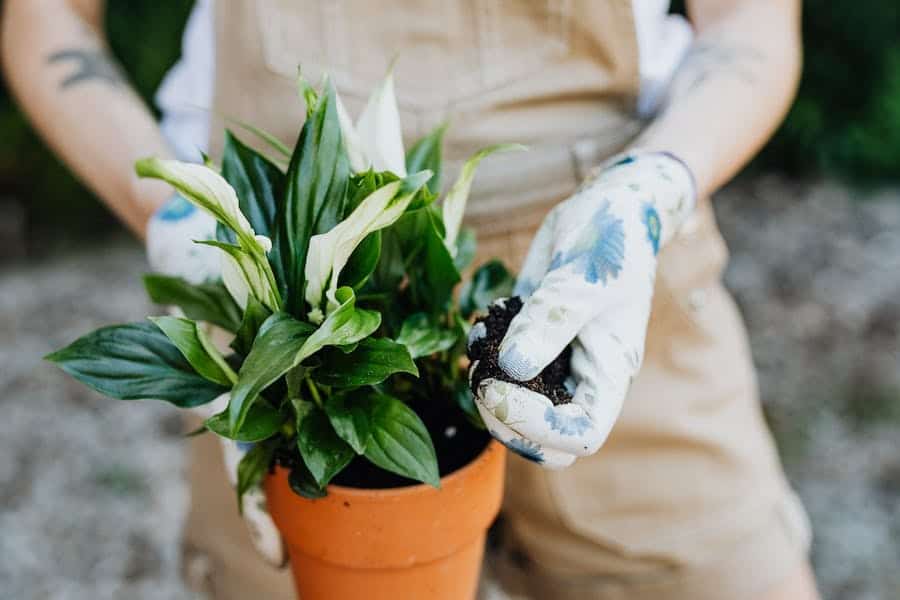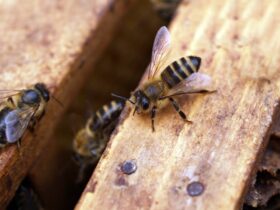A serene embodiment of tranquility and purity, the peace lily, with its lustrous leaves and ethereal white blooms, has long been adorning our spaces, cleansing our indoor air, and silently bestowing an unwavering calm upon us. But what happens when this emblem of peace begins to reveal a hidden struggle through brown, wilting tips on its otherwise immaculate leaves? It nudges us into a state of puzzled concern, prompting an immediate reflection: Why does my peace lily have brown tips? This seemingly mundane question unfolds a tapestry of potential causes and considerations regarding the nurturing of this beloved plant. For many, a peace lily is not merely a decorative entity; it is an intricate part of their living space, infusing it with a subtle elegance and refreshing vitality. Thus, observing a peaceful lily struggling with brown tips is not just a mere horticultural issue; it’s a call to understand deeper, to explore further, and to reassess the ways in which we extend our care to these gentle beings. In the ensuing lines, let’s delve into the myriad reasons behind the perplexing browning of our peace lily’s tips and traverse the journey from identifying the problems to executing remedial and preventative actions, ensuring our leafy companions thrive with vivacity.
Why Does My Peace Lily Have Brown Tips?
Brown tips on your Peace Lily can be indicative of several potential issues, such as inconsistent watering, exposure to direct sunlight, or nutrient deficiencies. Peace Lilies prefer evenly moist soil, so ensure you’re watering it when the top inch of the soil feels dry and avoid both over-watering and under-watering. Furthermore, while they appreciate bright, indirect light, direct sunlight can scorch their leaves, leading to browning. Lastly, insufficient nutrients or using the wrong fertilizer might also contribute to the problem. Regularly inspect your plant for signs of pests or disease to ensure it remains healthy and vibrant.
Possible Causes Of Brown Tips
The poetic beauty of a peaceful lily lies not only in its effervescent white blossoms but also in its vibrant, rich green foliage. So, when those elegant leaves present troublesome brown tips, it signals an urgent plea for help from your verdant companion. Let’s delve into the primary culprits behind this issue.
The most common reason associated with brown tips on peace lilies is improper watering habits. These plants crave consistency and are quite sensitive to both underwatering and overwatering. If the soil becomes too dry, the leaf tips may brown due to inadequate hydration. Conversely, overly saturated soil can suffocate the roots, leading to stress and a similar browning. A general rule of thumb is to water when the top inch of the soil feels dry, ensuring that the pot has adequate drainage to prevent waterlogging.
Another pivotal factor is the quality and type of water used. Peace lilies tend to be sensitive to chemicals commonly found in tap water, such as chlorine and fluoride. These chemicals can accumulate in the leaf tips, causing them to turn brown and die. Utilizing distilled or rainwater can mitigate this issue, providing your plant with a pure source of hydration.
A surprising yet significant factor contributing to brown tips is the ambient humidity or lack thereof. Peace lilies originate from tropical regions where high humidity is the norm. When they’re placed in an environment with dry air, the leaf tips can quickly become brown and crispy. Regular misting, placing a humidifier nearby, or grouping plants together are practical ways to augment the humidity around your peace lily.
Moreover, peace lilies can also exhibit brown tips when exposed to inadequate lighting conditions. These plants favor bright, indirect light, and when subjected to direct sunlight, the leaf tips might scorch and brown. Alternatively, too little light can also stress the plant, affecting its overall vitality and appearance.
Nutrient deficiencies, particularly a lack of magnesium or potassium, can also manifest as brown tips. Fertilizing your peace lily with a balanced, slow-release fertilizer during its growing season (spring and summer) can amend this. But be cautious, as excessive fertilization can also be detrimental, causing fertilizer burn and, yes, brown tips.
Lastly, always examine your peace lily for potential pest infestations or diseases, as these can also lead to browning and other issues. Regular inspections, prompt identification, and appropriate interventions are critical to manage pests and diseases effectively.
How Do I Get Rid Of Brown Tips On Leaves?
As a plant enthusiast, nothing feels more disheartening than witnessing the verdant leaves of your beloved flora developing unsightly brown tips. This subtle alteration in foliage aesthetics not only hampers the visual appeal but is also an urgent entreaty from your plant, communicating an underlying issue. The path to rejuvenating the lush greenery involves a mix of immediate rectification actions and long-term care strategies.
Snipping With Precision:
Begin by gently pruning the brown tips off your plant’s leaves. Utilize clean, sharp scissors or pruning shears to remove the affected areas, ensuring you follow the natural leaf shape to maintain aesthetics. Always clean your tools before moving to another plant to prevent potential cross-contamination of pests or diseases. Snipping not only immediately enhances the plant’s appearance but also allows it to redirect energy from attempting to repair damaged areas to fostering new growth.
Reassessing Watering Habits:
Correcting watering routines is paramount in preventing further browning. Ensure you are following the plant-specific watering needs closely. Generally, a thorough watering when the top inch of the soil is dry, using room-temperature, dechlorinated water, establishes a good baseline. Pay attention to your plant’s response to adjust the frequency and quantity as needed. Ensure that pots have sufficient drainage holes to avoid waterlogging, which could perpetuate root rot and subsequent leaf browning.
Modulating Environmental Conditions:
Analyze and rectify environmental conditions. If the air is too dry, consider placing a humidifier nearby or grouping plants together to raise ambient humidity. Alternatively, occasional misting can provide temporary relief from dry conditions. Ensure that your plant receives adequate light without being exposed to direct, harsh rays, which can scorch and brown the leaves. Employing sheer curtains or moving the plant to a location with filtered light can remedy this issue.
Evaluating And Adjusting Nutritional Inputs:
Review your fertilization routine, ensuring that you’re neither under-nourishing nor over-fertilizing your plant. Employ a balanced, slow-release fertilizer, and always follow the recommended dosage on the packaging. The periodic introduction of nutrients, especially during the growing season, supports robust, healthy growth, thus warding off issues like brown tips.
Pest And Disease Management:
Routinely inspect your plant for signs of pests or diseases. Employ natural pest control methods, such as neem oil or insecticidal soap, to manage infestations without resorting to harsh chemicals. For fungal or bacterial issues, removing affected leaves and modifying care to decrease vulnerability (like avoiding water on foliage) is key to managing and preventing recurrence.
Re-Potting And Root Inspection:
Sometimes, root issues might be the hidden culprits behind brown tips. Periodically inspect the roots for signs of rot or being bound. Re-potting into a slightly larger container with fresh, well-draining soil not only provides renewed nutrients but also ensures that the roots have ample space to grow and breathe.
Stabilizing Care Routines:
Maintain stability in care routines once you have found the sweet spot for your specific plant. Fluctuations in care can stress plants, potentially causing issues like browning tips. Keeping watering, feeding, and light exposure consistent will foster a stable environment that supports optimal growth.
Patience And Persistent Care:
Remember that recovery takes time. While you might halt the progression of brown tips, leaves that have already been affected will not revert to their original green. Continual care and prevention are crucial to fostering new, healthy growth.
Where Is The Best Place To Keep A Peace Lily?
Peace Lilies, scientific name Spathiphyllum, are celebrated not only for their elegant appearance but also for their relatively easy care, making them a favored choice among indoor plants. Determining the best place to house a peace lily involves considering several pivotal factors that influence its health and vitality.
- Abundant Indirect Light: Peace Lilies adore bright, indirect light. A location where it can bask in filtered sunlight, such as near a north or east-facing window shielded by sheer curtains, ensures that it receives adequate light without the threat of leaf scorching due to direct exposure.
- High Humidity Areas: As tropical plants, Peace Lilies thrive in high humidity. Therefore, consider placing them in spaces like bathrooms or kitchens where humidity tends to be higher. Alternatively, placing a humidifier nearby or creating a humidity tray with pebbles and water can also enhance the moisture levels in its environment.
- Away From Drafts: Locate your Peace Lily away from drafty windows or doors to protect it from sudden temperature changes. These plants prefer a stable environment, and abrupt shifts in temperature or exposure to cold drafts can stress the plant, potentially leading to browning leaves or inhibited growth.
- Within Safe Reach: Ensure that your Peace Lily is positioned where it’s safe from pets, as it contains compounds that are toxic when ingested by cats and dogs. An elevated shelf or a hanging planter can keep it out of reach from curious paws while still allowing it to adorn your living space.
- In A Well-Ventilated Spot: Despite their love for high humidity, Peace Lilies also appreciate good air circulation, which helps to prevent the onset of fungal diseases. Avoid cramming it amidst a tight cluster of other objects or plants, allowing the air to circulate freely around it.
Final Words
In conclusion, the brown tips on your peace lily convey a silent message of distress, often pointing towards inconsistencies in care or unfavorable environmental conditions. Understanding and meticulously addressing issues related to watering, lighting, humidity, and nutrient provision are pivotal in reviving its vitality. Embracing proactive, informed care strategies and maintaining a keen eye for subtle changes in its foliage will not only resolve the browning dilemma but also foster a flourishing, resilient plant that continues to enchant your living space with its verdant charm and elegant blossoms.
FAQ’s
Should I Cut Off Leaves With Brown Tips?
Yes, you can trim the brown tips off the leaves of your peace lily for aesthetic reasons and to prevent the plant from wasting energy trying to repair them. Use clean, sharp scissors to make precise cuts, following the natural shape of the leaves to maintain their beauty. However, also investigates and addresses the underlying cause of the browning to prevent it from recurring.
How Long Do Peace Lilies Live?
Peace lilies (Spathiphyllum) can live for several years when given proper care, often thriving for 3-5 years indoors and even longer in some cases. Providing consistent and appropriate care—adequate light, proper watering, and periodic fertilization—enhances their lifespan. Additionally, propagating through division can give life to new plants, continuing the legacy of your original peace lily.
Should I Put My Peace Lily In The Bathroom?
Peace lilies can do well in a bathroom if certain conditions are met. They appreciate the typically higher humidity levels found in bathrooms. However, they also require bright, indirect light, which can be a limiting factor in some bathrooms. If your bathroom receives sufficient natural light without exposing the plant to direct sunlight, it can be a suitable location for your peace lily. Always monitor your plant for signs of stress or discomfort and adjust its location as needed.




















Leave a Reply